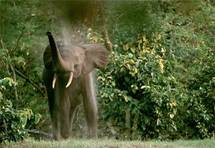
Tropical forests only account for seven-to-ten percent of the Earth's land area. But they hold up to half of the carbon locked inside the planet's terrestrial vegetation, giving them an outsized role in regulating greenhouse gases in the atmosphere.
Previous studies in South America have shown that Amazonian old-growth forests have absorbed, on average, an extra 620 kilogrammes (1,364 pounds) of carbon per hectare (2.47 acres) per year.
This adds up to some 650 billion kilos every year for the entire Amazon basin, which sits astride eight nations.
Before the new study, however, it was not known whether this trend was common to all tropical forests, or varied from one continent to another, especially in Africa.
Having this information is important to broader attempts to project changes wrought by global warming, and how quickly temperatures are likely to rise.
Two dozen international researchers led by Simon Lewis of the University of Leeds in northern England pulled together data from 79 monitoring plots scattered across 10 countries in western and central Africa.
Sifting through the data, the scientists found that the region's rain forests had pumped progressively more carbon dioxide out of the atmosphere as trees underwent photosynthesis and grew.
The average increase was almost identical to those for Amazonia, a net plus of 630 kilos per hectare each year between 1967 and 2007, reported the study, published in the British science journal Nature.
"African tropical forests are providing important ecosystem services by storing carbon and being a carbon sink, thereby reducing the rate of increase in atmospheric CO2," the main driver of global warming, the authors note.
At least one puzzle remains. Left alone, forests will eventually reach a point at which tree growth and death are in equilibrium, meaning they neither take in or give off extra carbon.
The question, then, is why these tropical forests are continuing to draw down ever more CO2.
"There are two possible explanations," said Helen Muller-Landau in a commentary published in Nature.
One is that major disturbances hundreds, or thousands, of years ago -- massive fires, drought, changes in land use -- destroyed portions of the forest which have been growing back ever since.
The second is that climate change has knocked tropical forests in South America and Africa off balance. "Perhaps the increase in atmospheric carbon dioxide is effectively fertilizing tropical tree growth," speculated Muller-Landau.
It is probable, she added, that both factors were at play.
Whether remaining intact forests will continue to sequester carbon is unknown, and will depend in part on how humans manage this precious resource, Lewis and colleagues conclude.
"With adequate protection, these forests are likey to remain large carbon stores in the longer term," they wrote.
------------------------------------
Previous studies in South America have shown that Amazonian old-growth forests have absorbed, on average, an extra 620 kilogrammes (1,364 pounds) of carbon per hectare (2.47 acres) per year.
This adds up to some 650 billion kilos every year for the entire Amazon basin, which sits astride eight nations.
Before the new study, however, it was not known whether this trend was common to all tropical forests, or varied from one continent to another, especially in Africa.
Having this information is important to broader attempts to project changes wrought by global warming, and how quickly temperatures are likely to rise.
Two dozen international researchers led by Simon Lewis of the University of Leeds in northern England pulled together data from 79 monitoring plots scattered across 10 countries in western and central Africa.
Sifting through the data, the scientists found that the region's rain forests had pumped progressively more carbon dioxide out of the atmosphere as trees underwent photosynthesis and grew.
The average increase was almost identical to those for Amazonia, a net plus of 630 kilos per hectare each year between 1967 and 2007, reported the study, published in the British science journal Nature.
"African tropical forests are providing important ecosystem services by storing carbon and being a carbon sink, thereby reducing the rate of increase in atmospheric CO2," the main driver of global warming, the authors note.
At least one puzzle remains. Left alone, forests will eventually reach a point at which tree growth and death are in equilibrium, meaning they neither take in or give off extra carbon.
The question, then, is why these tropical forests are continuing to draw down ever more CO2.
"There are two possible explanations," said Helen Muller-Landau in a commentary published in Nature.
One is that major disturbances hundreds, or thousands, of years ago -- massive fires, drought, changes in land use -- destroyed portions of the forest which have been growing back ever since.
The second is that climate change has knocked tropical forests in South America and Africa off balance. "Perhaps the increase in atmospheric carbon dioxide is effectively fertilizing tropical tree growth," speculated Muller-Landau.
It is probable, she added, that both factors were at play.
Whether remaining intact forests will continue to sequester carbon is unknown, and will depend in part on how humans manage this precious resource, Lewis and colleagues conclude.
"With adequate protection, these forests are likey to remain large carbon stores in the longer term," they wrote.
------------------------------------









 Home
Home Politics
Politics









